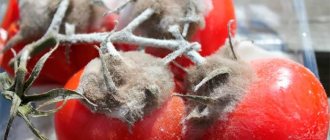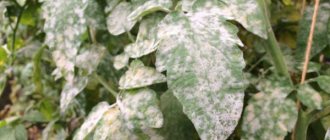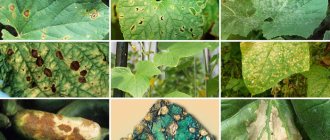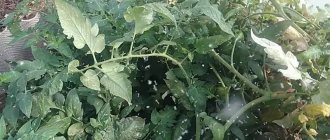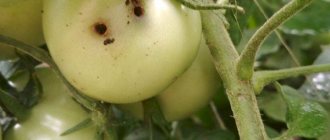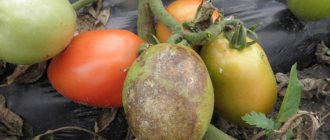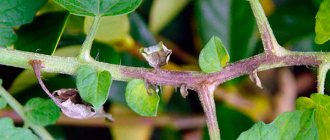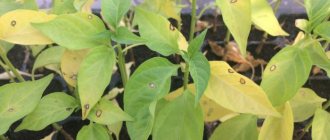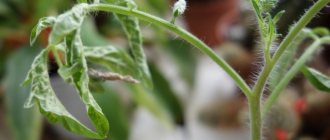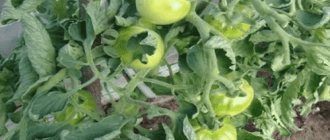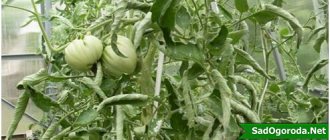Tomatoes are among the most popular agricultural crops.
Almost every summer cottage has beds with this plant. Dear readers!
For you, we have created communities on social networks in which useful articles and interesting ideas are published several times a day! Subscribe and receive useful content in a convenient format! Tomatoes are susceptible to many diseases: fungal, viral, bacterial, caused by insect pests, etc. In this article we will talk about blossom end rot. You will learn what this disease is, why it occurs and how to treat it.
What is blossom end rot of tomatoes?
Blossom rot on tomatoes
Blossom blossom of tomatoes is a non-infectious disease. Most often it occurs due to calcium deficiency in the plant. This element is part of the salts that are needed to form tomato pulp. If there are not enough of them, then tissue necrosis begins in the fetus and the apex turns black.
REFERENCE. The apex is the part of the tomato that is farthest from the stem.
Gray leaf spot
Gray leaf spot is otherwise called macrosporiosis and has nothing to do with gray rot. Gray spot in tomatoes is caused by fungi of the genus Stemphylium solani, and the causative agent of gray rot is the bacterium Botrytis cinerea Pers.
If a plant becomes infected with macrosporiosis, gray spots form on the leaves, which subsequently affect the leaves completely and the plant dies. When a plant becomes infected with gray rot, the stem is affected: it becomes covered with gray spots with an ashy coating. Subsequently, vascular necrosis develops inside the stem, and the foliage begins to turn yellow.
Why does disease develop in tomatoes?
There are many reasons for calcium deficiency. The most important of them is the insufficient amount of this microelement in the soil. Among others, the following can be noted:
- Moisture deficiency in the soil. Because of this, calcium is simply not absorbed by the roots of the plant.
- Excess moisture in the soil. When water stagnates in the soil, as well as the proximity of groundwater, calcium is washed out of the soil. Accordingly, the plant has nowhere to get the required amount of this microelement.
- Chemical composition of the soil . If the soil is too saline or acidic, it will not have enough calcium.
- Root injuries. Tomatoes take nutrients from the soil using the root system. If it is damaged, the plant will not be able to receive microelements and will begin to hurt. Including apical rot.
- Stress. Tomatoes are a crop that does not like sudden changes in growing conditions. Watering with cold water, a sharp change in temperature - all this negatively affects tomatoes and leads to calcium deficiency. For example, when watering with cold water, the roots cannot absorb nutrients for some time.
Late blight
Late blight or late blight is one of the most dangerous diseases of tomatoes. It can develop suddenly and spread over a few days to other plants, causing them to die. The causative agent is spores of a fungus with the same name.
Causes of late blight
- lack of proper ventilation;
- disruption of air circulation due to too frequent planting and poor planting of tomatoes;
- formation of condensation on the back side of the protective film;
- cold rains are favorable for the development of late blight;
- sharp day-night changes and insufficiently warm temperatures.
The first signs of the disease on tomatoes, as a rule, are already on the 8-10th day of infection.
Signs of late blight
Characteristic signs of the disease include characteristic rapidly growing brown-gray spots on the back of the leaf. A thin white coating is also characteristic of this same part. Over the course of a few days, the spots enlarge and merge, the leaf shrinks and flies off.
Following the green part, the fruits become infected in a similar way, turning black and falling off.
Manifestation of tomato late blight
Signs of infection
Initial stage of the disease
The most important symptom of the disease is the appearance of a yellow-brown spot on the top of the tomato. In this case, signs of blossom end rot begin to appear on fairly developed fruits. During the ripening process, the spot becomes dark brown and seems to be pressed into the inside of the tomato.
Blossom rot is not the result of infection or pest action, but the affected area is often the site where fungus soon begins to develop.
Another symptom of the disease is rotting of the fruit pulp without external changes. In this case, it is impossible to detect the disease before harvesting.
REFERENCE. A tomato affected by blossom end rot turns red earlier than others. But usually on one bush almost all the fruits suffer from blossom end rot.
Fusarium
Fusarium is the least dangerous disease of all that can cause rot. However, in the absence of proper treatment, the probability of tomato death is very high. It occurs during the active stage of growth and flowering.
Causes of fusarium
- infected seeds;
- possible cuts and transfer of sources naturally;
- low temperature during sowing, below 14°;
- activation of infection at temperatures during the flowering period up to 28°C;
Fusarium wilt of tomato
Signs of fusarium
- direction of spread: from the lower leaves to the top;
- the leaves and trunk become pale green with a yellow tint;
- curling and falling of leaves;
- the upper shoots dry out;
- A light white coating appears on the roots and pink at the root neck.
Rotten diseases spread not only to tomatoes, but also to nearby crops.
Treatment of blossom end rot in tomatoes and is it possible to save the plants?
Blossom rot does not affect the entire plant, so if detected in a timely manner, the bush can be saved.
Firstly , you need to pick off the affected fruits. Under no circumstances leave them to rot in the garden beds. Sick tomatoes should be disposed of outside the garden.
Secondly , the plant needs to be fed with fertilizer with a high calcium content (for example, calcium nitrate or potassium chloride). Saturation with this microelement will stop the development of the disease.
Thirdly , cultivate the soil. Loosen it if it gets crusty. Water if it is completely dry.
Affected fruits must be destroyed
What medications to treat for the disease
Chemicals are the most effective remedy for blossom end rot. The fact is that they already contain the required dose of calcium.
IMPORTANT! Before feeding tomatoes, they must be watered abundantly. This way, minerals will be better absorbed by plants.
Among the most effective drugs:
- Calcium nitrate. Spraying with a solution (10 g per 10 liters of water).
- Calcium chloride. Spraying with a solution (30 g per 10 liters of water).
- "Brexil Sa." Treatment of leaves and stems with a solution (10 g per 10 l of water).
- "Nutrivant PLUS" and "Fertivant" . Spraying with a solution of 2 drugs (30 g per 10 liters of water).
Nutrivant PLUS
Treatment with these agents should be carried out every 1.5 - 2 weeks after detection of the disease. If new fruits do not show signs of blossom end rot, then spraying can be stopped.
Treatment with folk remedies
If you prefer traditional methods, then, first of all, you need to pay attention to wood ash, soda, chalk and oak bark . Fertilizers based on these products are rich in calcium. Fertilizers are applied in liquid form and mainly by foliar application (spraying). Only the chalk “chatter” is applied at the root.
- Ash based fertilizer. 1 glass is sifted and mixed with 1 glass of boiling water. The concentrate is infused for a day, after which it is diluted with 9 liters of water.
- Chalk "chatterbox". Watering with a solution (100 g per 10 liters of water) under the root.
- Oak bark is ground into crumbs. A teaspoon of the product is poured into 1 liter of water and boiled for 10 minutes. Then the concentrate is diluted with 9 liters of water.
- Soda solution. 2 teaspoons are diluted in 10 liters of water.
Treatment with solutions should be carried out once a week. The entire bush is processed. And fruits, and leaves, and stems. Particular attention should be paid directly to tomatoes. If symptoms of blossom end rot no longer appear, treatment should be stopped.
IMPORTANT! There is no need to process tomatoes after the signs of the disease disappear. An excess of any microelements is also harmful to plants.
Processing methods
Treatment of blossom end rot on tomatoes can be carried out using both root and foliar methods. The first involves watering the affected plants at the root, the second involves spraying the affected areas of the tomato bush with a spray bottle. Each of these methods has its own nuances and features.
Foliar
Foliar treatment of tomato bushes “by leaf” is considered more effective than root application of folk or industrial means. Blossom rot affects only the fruits and does not affect the foliage and stems, so processing the fruits ensures a rapid supply of active substances directly to the lesion. Due to this, quick results are achieved.
Root
Root treatment of tomatoes involves watering the tomatoes with a prepared solution under the root. This method is suitable for both industrial preparations and folk remedies. But it must be taken into account that when applied by roots, the products have a slower, cumulative effect than when spraying the affected areas of tomatoes.
How to deal with rot on tomatoes in a greenhouse?
Methods of combating blossom end rot on tomatoes growing in a greenhouse are also aimed at eliminating calcium deficiency in the soil and creating favorable conditions for plants.
Small differences are due to the fact that tomatoes in a greenhouse are less susceptible to atmospheric influences.
Firstly , watering is carried out only by hand. Therefore, it is important to establish a regime of watering and subsequent loosening of the soil.
Secondly , it is necessary to regularly ventilate the greenhouse to ensure a flow of fresh air.
Otherwise, you can use the same means as in the fight against blossom end rot on open ground tomatoes.
Types, their descriptions and photos
Among the diseases of tomatoes, there are several types of rot. These include gray, white and black rot. Each type of rot is caused by a different pathogen and manifests itself differently.
Gray
The disease affects fruits growing both in open ground and in greenhouse conditions. The cause of gray rot is considered to be high humidity and excessive amounts of nitrogen fertilizers.
White
The primary sources of the disease are compost and soil, so infected plants must be destroyed and cannot be composted. The causes of white rot are undisinfected soil. Its development is promoted by high humidity and low air temperature (below 18ºС) during planting.
Black
The causative agent of the disease penetrates into overripe fruits through the cracks formed. The cause of the disease is excessive air humidity.
Are there resistant varieties?
One of the most effective methods of resisting blossom end rot is the selection of disease-resistant varieties.
Early-ripening and large-fruited varieties and hybrids of tomatoes are most susceptible to the disease. For example, “Azhur”, “Sprint Timer” and “Alabai”. During development, tomatoes of these varieties very quickly consume too much energy. Therefore, if they are not carefully looked after and fertilized, they may get sick.
The varieties and hybrids least susceptible to blossom end rot are “Bolshevik”, “Belyi Naliv”, “Pandarose”, “Volgogradsky”, “Lunny”, “Benito”, “Astrakhansky”, “Raisa”, etc. Most of these tomatoes are unpretentious in care and can withstand climatic changes and irregular watering regimes.
Variety White filling
Disease prevention
It is much more effective to prevent the occurrence of a disease than to fight it. Prevention of blossom end rot is carried out throughout the summer season. It is very important to take into account the climatic characteristics of the region, as well as the fertility and chemical composition of the soil.
In addition, it is very important to properly care for tomatoes: water and feed them on time, rooting, treating with insecticides and fungicides, loosening the soil, etc.
The fact is that crown rot is not the result of an infection or fungus. In most cases, the disease is associated with improper care of plants and soil.
That's why:
- Carry out regular loosening on heavy soils and with high groundwater levels.
- Do not allow the soil under the tomatoes to dry out.
- On heavy soils, carry out liming in the fall after the end of the dacha season.
- Mulch tomato bushes.
- Fertilize the soil on the site in spring and autumn.
- Keep an eye on your tomatoes and conduct regular inspections for diseases and pests.
How to prepare seeds so that tomatoes do not get sick?
Treating seeds in potassium permanganate
Proper preparation of seeds will prevent disease even for those varieties that are more prone to blossom end rot than others.
In order to prevent disease, tomato seeds must be pickled in a solution of potassium permanganate or iron sulfate before planting.
- Etching with potassium permanganate. A 3% solution is prepared. The seeds are soaked in it for 30-40 minutes. Then the planting material is washed in warm water and dried.
- Pickling with iron sulfate. A solution is prepared (1 g of vitriol per 1 liter of water). The seeds are soaked in it for 24 hours. After this, the planting material is also washed and dried.
IMPORTANT! If your soil is too low in calcium or you severely damage the plant's roots, seed dressing still won't help.
Answers to frequently asked questions
Where does blossom end rot come from?
Blossom rot is a disease that is associated with calcium deficiency. Without this element, the plant cannot fully form the fruit, on which tissue begins to die. The tomato begins to turn black.
How to feed tomatoes so they don't get sick?
First of all, fertilizers containing calcium. Foliar feeding, that is, spraying, is much more effective.
Does the soil need to be tilled?
Tomatoes get calcium from the soil, so it also needs to be processed. On acidic soils, liming is carried out in the fall. This is necessary to reduce the acidity of the soil. Liming can also be carried out in the spring, but the effect will be slightly lower.
Only the very tip of the tomato turned black. What to do with him?
Pluck from the branch and throw outside the garden or summer cottage. There is no need to eat a diseased tomato, even if you cut off the infected part. Eating contaminated tomatoes can cause gastrointestinal upset and several days of fever.
The tomatoes on the tomato bush are turning black. What to do with the plant itself?
Treat using the methods described. If treatment does not help, then the infected bush should be pulled out and burned outside the summer cottage.
